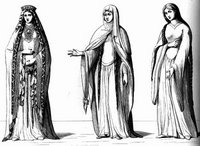early Medieval fashion peroid

Medieval clothes history traditionally begins with the fall of the Western Roman Empire in AD 476. The transition from classical to the medieval clothing was more gradual. The Byzantine Empire continued for another thousand years, with both sexes of the upper classes wearing the tunic as the basic garment. In the West, the invasions from the north brought trousers, fitted tunics, and hoods, but it was nearly three centuries before any recorded Western style evolved from the interaction of Roman and northern European forms of dress.
Vast tribal movements took place in the Dark Ages but the earlier Teutonic invasions had small effect other than the introduction of trousers to the Romans. The Teutons adopted Roman dress, as had the Gauls and at least some the Britons.
The Romanesque an
 d early gothic period lasted from about 1000-1350. New materials and colors arrived and fashion took a leap as imported goods were easier to get. The fitted tunic remained the main article of clothing but breeches and hose took the place of trousers and cloths also took on decorations such as jewels, embroidery, and fur trimmings. Because knitting was not yet established, hose were often made of wool or linen and were cut to fit very tight. The 12th century hose were about mid thigh and meant to cover short breeches..
d early gothic period lasted from about 1000-1350. New materials and colors arrived and fashion took a leap as imported goods were easier to get. The fitted tunic remained the main article of clothing but breeches and hose took the place of trousers and cloths also took on decorations such as jewels, embroidery, and fur trimmings. Because knitting was not yet established, hose were often made of wool or linen and were cut to fit very tight. The 12th century hose were about mid thigh and meant to cover short breeches..After the Carolingians established political supremacy in a large part of Europe and Charlemagne became Holy Roman emperor in AD 800, he essentially wore the dress of a Byzantine emperor. Unlike Byzantine emperors, Charlemagne only wore robes on state occasions. His everyday attire consisted of an under tunic, an over tunic with a colored silk border, and breeches or trousers cross-gartered to the knee. He also wore a semicircular cloak fastened at the shoulder and a round cloth cap. Illuminated manuscripts show other European monarchs wearing similar styles.
Throughout the Anglo-Saxon period (450-1100) women wore a fairly slender undergarment, or shift, with long, narrow sleeves. In coloured illustrations this is generally white, indicating linen, although poorer woman may have had little choice but to wear wool next to the skin. It is not known how long the shift was, and it most probably varied in length. Linen shifts were valuable enough to be mentioned by several testatrix in their wills. No underpants were worn. (Of all the garments considered essential today, these were the most recently adopted, coming into general use only in the late eighteenth century. The sanitary napkins used by our Anglo-Saxon fore-mothers were most likely sewn linen pads stuffed with wool fleece, or perhaps layer upon layer of linen sewn together. These would have been set inside a close-fitting pair of drawers worn expressly for this purpose. Recall that commercially made disposable napkins only date to the third decade of the twentieth century.)
Stockings, either woven and then cut and sewn to fit, or fashioned by the technique known today as nålbinding , were held up by knee garters fashioned of wool strips.
Thanks to:
Medieval clothing.com
Octavia.net


0 Comments:
Post a Comment
<< Home